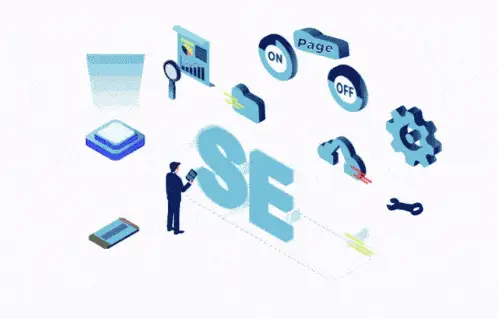

Search engines have a single goal only. They aim to provide users with the most relevant answers or information. Every time you use them, their algorithms choose pages that are the most relevant to your query. And then, rank them, displaying the most authoritative or popular ones first. To deliver the right information to users, search engines analyze two factors: Relevancy between the search query and the content on a page.
Search engines assess it by various factors like topic or keywords. Authority, measured by a website’s popularity on the Internet. Google assumes that the more popular a page or resource is, the more valuable is its content to readers. And to analyze all this information they use complex equations called search algorithms.
To optimize a site, you need to improve ranking factors in three areas — Technical Website Setup, Content, and Links. So, let’s go through them in turn.
For your website to rank, three things must happen:
First, a search engine needs find your pages on the Web. Then, it must scan them to understand their topics and identify their keywords. And finally, it needs to add them to its index — a database of all the content it has found on the web.
This way, its algorithm can consider displaying your website for relevant queries. Seem simple, since you can visit your site without any problem, so should Google, right? Unfortunately, there is a catch. A web page looks different for you and the search engine. You see it as a collection of graphics, colors, text with its formatting, and links. To a search engine, it’s nothing but text. As a result, any elements it cannot render this way remain invisible to the search engine. And so, in spite of your website looking fine to you, Google might find its content inaccessible.


Every time you use a search engine, you’re looking for content — information on a particular issue or problem, for example.
True, this content might come in different formats. It could be text, like a blog post or a web page. But it could also be a video, product recommendation, and even a business listing. It’s all content. And for SEO, it’s what helps gain greater search visibility.
For one, content is what customers want when searching. Regardless of what they’re looking for, it’s content that provides it. And the more of it you publish, the higher your chance for greater search visibility.
But also, search engines use content to determine how to rank a page. It’s the idea of relevance between a page and a person’s search query that we talked about earlier.
While crawling a page, they determine its topic. Analyzing elements like page length or its structure helps them assess its quality. Based on this information, search algorithms can match a person’s query with pages they consider the most relevant to it.
From what you’ve read in this guide so far, you know that no page will rank without two factors — relevance and authority.
In their quest to provide users with the most accurate answers, Google and other search engines prioritize pages they consider the most relevant to their queries but also, popular.
The first two areas — technical setup and content — focused on increasing relevancy (though I admit, some of their elements can also help highlight the authority.)
Links, however, are responsible for popularity.
But before we talk more about how they work, here’s what SEOs mean when talking about links.
Links, also called backlinks, are references to your content on other websites. Every time another website mentions and points their readers to your content, you gain a backlink to your site.
For example, this article in Entrepreneur.com mentions our marketing statistics page. It also links to it allowing their readers to see other stats than the one quoted.
Google uses quantity and quality of links like this as a signal of a website’s authority. Its logic behind it is that webmasters would reference a popular and high-quality website more often than a mediocre one.
Links, also called backlinks, are references to your content on other websites. Every time another website mentions and points their readers to your content, you gain a backlink to your site.
For example, this article in Entrepreneur.com mentions our marketing statistics page. It also links to it allowing their readers to see other stats than the one quoted.
Google uses quantity and quality of links like this as a signal of a website’s authority. Its logic behind it is that webmasters would reference a popular and high-quality website more often than a mediocre one.


Search engines have a single goal only. They aim to provide users with the most relevant answers or information. Every time you use them, their algorithms choose pages that are the most relevant to your query. And then, rank them, displaying the most authoritative or popular ones first. To deliver the right information to users, search engines analyze two factors: Relevancy between the search query and the content on a page.
Search engines assess it by various factors like topic or keywords. Authority, measured by a website’s popularity on the Internet. Google assumes that the more popular a page or resource is, the more valuable is its content to readers. And to analyze all this information they use complex equations called search algorithms.
To optimize a site, you need to improve ranking factors in three areas — Technical Website Setup, Content, and Links. So, let’s go through them in turn.
For your website to rank, three things must happen:
First, a search engine needs find your pages on the Web. Then, it must scan them to understand their topics and identify their keywords. And finally, it needs to add them to its index — a database of all the content it has found on the web.
This way, its algorithm can consider displaying your website for relevant queries. Seem simple, since you can visit your site without any problem, so should Google, right? Unfortunately, there is a catch. A web page looks different for you and the search engine. You see it as a collection of graphics, colors, text with its formatting, and links. To a search engine, it’s nothing but text. As a result, any elements it cannot render this way remain invisible to the search engine. And so, in spite of your website looking fine to you, Google might find its content inaccessible.
Every time you use a search engine, you’re looking for content — information on a particular issue or problem, for example.
True, this content might come in different formats. It could be text, like a blog post or a web page. But it could also be a video, product recommendation, and even a business listing. It’s all content. And for SEO, it’s what helps gain greater search visibility.
For one, content is what customers want when searching. Regardless of what they’re looking for, it’s content that provides it. And the more of it you publish, the higher your chance for greater search visibility.
But also, search engines use content to determine how to rank a page. It’s the idea of relevance between a page and a person’s search query that we talked about earlier.
While crawling a page, they determine its topic. Analyzing elements like page length or its structure helps them assess its quality. Based on this information, search algorithms can match a person’s query with pages they consider the most relevant to it.
From what you’ve read in this guide so far, you know that no page will rank without two factors — relevance and authority.
In their quest to provide users with the most accurate answers, Google and other search engines prioritize pages they consider the most relevant to their queries but also, popular.
The first two areas — technical setup and content — focused on increasing relevancy (though I admit, some of their elements can also help highlight the authority.)
Links, however, are responsible for popularity.
But before we talk more about how they work, here’s what SEOs mean when talking about links.
Links, also called backlinks, are references to your content on other websites. Every time another website mentions and points their readers to your content, you gain a backlink to your site.
For example, this article in Entrepreneur.com mentions our marketing statistics page. It also links to it allowing their readers to see other stats than the one quoted.
Google uses quantity and quality of links like this as a signal of a website’s authority. Its logic behind it is that webmasters would reference a popular and high-quality website more often than a mediocre one.


